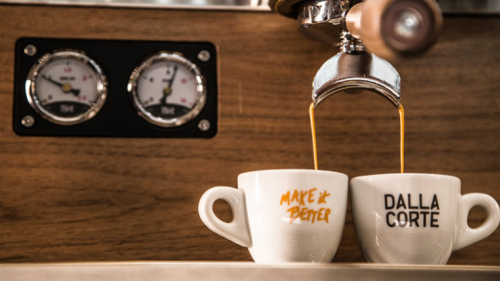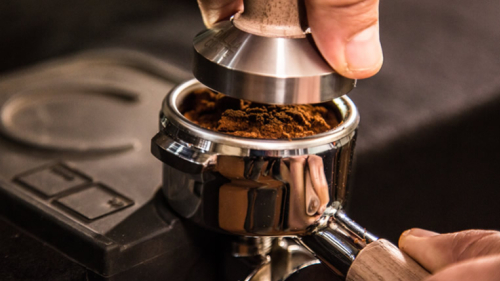Barista vs Machine
Dec 18, 2019
Source:
Perfect Daily Grind
Try to
imagine a coffee shop without a barista. Now try to imagine it without an
espresso machine. Which seems the most improbable?
Machines
have been a quintessential part of the coffee shop for over a century, while
the smiling barista has become a cliché both in and outside of the coffee
industry. But as machinery keeps developing and our customer service and coffee
expectations grow, what roles do the two play? Can one replace the other? How
is the job of the barista changing?
The
Importance of Skilled Baristas
A barista
does far more than press buttons on an espresso machine. They understand coffee
extraction and create and troubleshoot recipes. They dial in profiles. They
look after the equipment, cleaning machinery and spotting problems. They steam
milk and pour latte art.
They also
provide excellent customer service, ensuring that customers are satisfied and
return to the shop. They adapt to individual customers’ needs, from oat milk to
clock systems for the visually impaired (“your coffee is at 3 pm and your
muffin is at 5 pm”). They cross-sell and up-sell, boosting the café’s profits
per transaction.
They work
together as a team, mentoring and motivating other baristas, and in doing so
create a positive shop environment. They keep the bar and the tables clean, and
check that there are enough napkins on the condiment table. They politely ask
customers with trailing laptop cables to sit closer to the socket to avoid
creating a hazard for people in wheelchairs or with prams.
A skilled barista isn’t just responsible for the coffee being served. They work to meet all the customers’ needs and ensure the shop runs smoothly.
How
Machines Make The Barista’s Job Easier
New tools
are constantly being developed, while today’s espresso machines come with an
impressive array of features. Baristas can dial in via apps and use water fonts
with a temperature precision of 0.1°C.
These tools
increase efficiency but also improve consistency, reduce the likelihood of
errors, and create a healthier work environment. Let’s take a look at some of
the ways new equipment can help a coffee shop run smoother.
• Scales
Scales
improve consistency and accuracy by allowing baristas to assess and control the
ratios of all the drinks they make. Simone Guidi is a Dalla Corte Brand
Ambassador and the owner of La Sosta Specialty Coffee in Florence, Italy. He
says, “Of course, the scale is important to be sure that you are working with the
quantity of ground coffee that you wanted. Because if for some reason, the
coffee weighed more or less than you expected or wanted, the result is going to
be different.”
There are
workarounds. Simone tells me that if he didn’t have a scale, he would work with
cups with lines drawn inside them. “The line inside the cup is just a
reference,” he says, explaining that it measures output by volume instead of by
weight. “It’s not super-precise like a scale, but it’s something that can help
you.”
However,
this creates extra work for the barista. They have to calculate where the line
should be, mark the cups before they begin working, and make sure they always
use the right cup. It’s also not as precise as measuring by weight. Having a
scale means the barista can work accurately with any cup, which frees up time
for them to focus on other things.
Moreover,
not all scales are the same. A high-quality, waterproof, and heat-resistant one
will allow baristas to work efficiently and consistently, meaning that they can
focus on providing better service. The scale will measure the ground coffee
accurately, and should water splash onto it, the barista won’t have to rush for
a towel. Instead, they can finish creating the customer’s drink, serve it with
a smile, and then dry the scale off.
• Tamping Tools
From
distribution and levelling tools that help ensure an evenly packed and tamped
puck to automated tamping tools like the PuqPress, there is a wide range of
tamping tools to choose from.
Simone
tells me, “The leveller for sure is a tool that is important, because if you
are not an expert barista, it helps you to tamp more evenly.” He points out
that it improves consistency and is useful for trained and proficient baristas,
as well as trainees.
As a
roaster, he often provides coffee to specialty coffee shops. He tells me, “I
have given [levellers] to three of my customers and they’ve got much better
results… Because now they are better at tamping, and of course, now they are
extracting the coffee better. This is something that I can tell you works.”
Automated
tamping tools also ensure consistent, even tamping, but with the bonus of
reduced physical effort. As a result, baristas are less likely to experience a
repetitive strain injury and can continue working comfortably and safely for
longer.
• The Espresso Machine
It’s the
most prominent piece of equipment in the coffee shop, often placed on the
counter so the customer can see it. The espresso machine is a polished piece of
art, but how much difference can it make to a barista’s workflow?
Simone
gives me the example of the newly launched Dalla Corte Zero, which is capable
of measuring and controlling water flow from the group showers in grams per
second. He tells me that this allows baristas to modulate extraction, since
they can control flow rate. In turn, this means a trained barista with an
understanding of the relationship between flow rate and extraction can better
control the quality and consistency of the espressos they’re pulling.
The Zero is
not the only machine to offer flow rate control – the Mina does as well, for
example. Yet Simone points out that on the Zero, baristas can regulate the flow
rate from the digital screen. This allows them to do so quickly, meaning more
of their attention can be focused on the customer or on steaming the milk.
Any machine where settings can be amended on a digital screen will reduce the amount of work needed from the barista, allowing them to respond quicker, have greater control, and also work on other tasks. Simone says, “[With a digital screen], if you want to change the temperature of your espresso, in just a very short time you can change it.”
Can High-Tech Machines Work Without Skilled Baristas?
From flashy
coffee-making robots to automated pour over machines, there are increasingly
more options on the market that promise to do away with the barista altogether.
I ask
Simone if he thinks robots can replace baristas. He tells me that if we were
just talking about making coffee, then yes. “A robot can make a very good
espresso,” he says.
Yet he
wouldn’t want to replace all baristas with machines. “This is my opinion, but
as everyone knows, the barista’s job is not just a question of making a good
espresso. Also, when I talk about my specialty coffee brand, it’s not just a
question of selling a good product. It’s a question of giving an experience to
the customer…
“Of course,
there is a part that can be replaced by a robot, but another part comes from
your intelligence, your brain, your experience. That will never be substituted
by a robot.”
A robot
cannot offer the same customer service as a human barista, nor can they
currently show as much adaptability. From giving customers recommendations to
troubleshooting issues, there is much that we still rely on human baristas to
do.
Similarly,
there is a huge difference between a trainee barista and a skilled one. Simone
says, “The more skilled you are, the more you can play with the machine.”
He gives
the example of controlling flow rate to alter a coffee’s profile in the cup.
“In order to give a different result, in order to help if the roaster didn’t
roast the coffee at the best, with a machine like the Zero you can rebuild the
cup or help make the cup better. But you have to have good skills for tasting
and to understand espresso extraction.”
So, in the
barista vs machine debate, who wins? Both. The best option of all is to have a
highly competent barista operating top-of-the-range machinery. Good machinery
will make a barista’s job easier, while a skilled barista can take advantage of
all the functions that the machine offers. In the pursuit of high-quality
coffee and excellent customer service, both machines and baristas are
essential.

Latest news
THIRD WAVE COFFEE: THE NEW ERA OF QUALITY COFFEE
Feb 18, 2025









